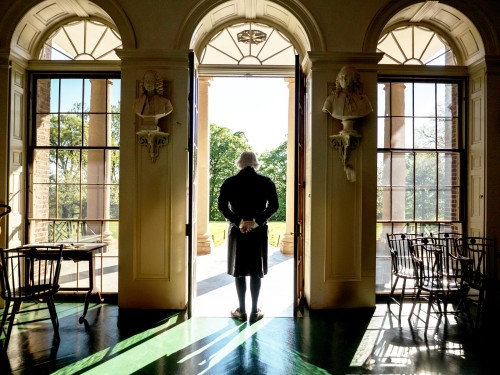As he reviewed the reports of the Lewis and Clark expedition, Thomas Jefferson read of encounters with the Sioux, Mandan, Shoshone, Nez Perce, and various other Native American communities. Although these Indian Nations were relatively new to Jefferson, American Indians were not, as his personal encounters with Indians began during his boyhood in Virginia and extended through his public career and into his retirement. Over time and in varying circumstances, he viewed Native Americans as subjects of intellectual curiosity or saw them in political terms as enemies in war or partners in peace. Jefferson's long public career during a formative time period allowed him to shape the relations between the United States and the various Indian nations in the eighteenth and early nineteenth centuries and beyond.
Jefferson the Virginian and American Indians
In his retirement years Jefferson recalled the Indians he had encountered as a boy in Virginia, noting especially the Cherokee warrior, Outassete. But such events would have already been fairly rare in the Virginia of Jefferson's boyhood. By the time of his birth in 1743, the Indian presence in Virginia had been greatly diminished by disease and warfare with white settlers. The Indian nations remaining inside Virginia were small in size and included the Algonkian-speaking nations that were remnants of the once powerful Powhatan Confederacy, the Siouan-speaking nations such as the Monacan, Saponi and Tutelo, and a group of Iroquoian-speakers, the Meherrin, among others. As their populations dwindled, Virginians became less concerned with these Indian communities and more preoccupied with the powerful Indian nations outside their borders, as settlements of white and black Virginians now extended to the foot of the Appalachian Mountains.
In 1744 Virginia signed a treaty with the Iroquois that granted land on the west side of the Appalachians to Virginia. The Iroquois claimed to have conquered all of the nations of the Ohio Valley, so the Virginians could, in turn, claim land rights to all the Ohio Valley and the area around the Great Lakes. The Indians of the Ohio Valley, particularly the Shawnee and the Miami, did not acknowledge such claims and violently resisted the attempts of Virginians to settle in what is today West Virginia, Kentucky, and western Pennsylvania. In order to reduce the ensuing violence along the frontier, King George III issued a proclamation in 1763 that prohibited any British settlements west of the Appalachians. But as agents employed by the British ministry continued trading with the Ohio Valley Indians, colonists tended to view their conflicts with the Shawnee and Miami Indians coupled with the King's proclamation as a plot to curtail their rights. These issues became imbedded in the Declaration of Independence when Jefferson wrote that the King had "endeavored to bring on the inhabitants of our frontiers, the merciless Indian savages, whose warfare is an undistinguished destruction of all ages, sexes, and conditions." Jefferson's description of American Indian warriors as "merciless savages" was not atypical of the manner in which many mid-eighteenth-century white Virginians viewed the Native Americans.
Yet as Governor of Virginia during the Revolutionary War, Jefferson welcomed a delegation from the Kaskaskia Indians. This followed a campaign in the Ohio Valley of Virginia militia led by George Rogers Clark, older brother of William Clark. There, Clark made alliances with some of the Indian nations, including the Kaskaskia of the Illinois country, and then attacked the British and the Indians allied with them at villages in present-day Illinois and Indiana. This warfare put Virginia's government into direct contact with western Indian nations and precipitated the visit of the Kaskaskia delegation with Virginia's governor.
In an exchange of speeches with the leader of the Kaskaskia, a chief of partial French ancestry named Jean Baptiste du Coigne, Jefferson expressed his ambitions for the future of the Anglo-American and Native American relationship. He looked forward to the day when the Indians would adopt white American ways and the two groups would live together in peace. Jefferson's speech prefigured the manner in which he, and most white Americans, would view American Indians in the decades to come. They worried about Indians becoming enemies in times of war, and they sought to keep them at peace through treaties and through a project of "civilization" that would try to make Indian culture resemble that of the Anglo-Americans.
